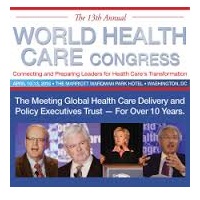 On Sunday, April 10, 2016, the National Association for Trusted Exchange (NATE), DirectTrust (@DirectTrustorg) and the Electronic Healthcare Network Accreditation Commission (EHNAC) (@EHNAC) – all organizations with a focus on the success of Direct secure messaging – joined together to talk about interoperability in healthcare. In a pre-conference workshop affiliated with the 13th Annual World Health Care Congress, the three organizations presented from three very different perspectives on “The Demand for Secure Interoperable Health Information Exchange: Options and Opportunities 2016,” creating a dynamic that echoed the recurring theme of the complementary nature of the organizations’ work.
On Sunday, April 10, 2016, the National Association for Trusted Exchange (NATE), DirectTrust (@DirectTrustorg) and the Electronic Healthcare Network Accreditation Commission (EHNAC) (@EHNAC) – all organizations with a focus on the success of Direct secure messaging – joined together to talk about interoperability in healthcare. In a pre-conference workshop affiliated with the 13th Annual World Health Care Congress, the three organizations presented from three very different perspectives on “The Demand for Secure Interoperable Health Information Exchange: Options and Opportunities 2016,” creating a dynamic that echoed the recurring theme of the complementary nature of the organizations’ work.
Dr. David Kibbe, President and CEO of DirectTrust, led the day with a discussion of the factors and players involved in interoperability in healthcare, including some predictions on the future expansion and contraction of various networks. Lee Barrett, Executive Director of EHNAC, focused his comments on the potential security risks involved in interoperability and the importance of maintaining a risk management strategy. Aaron Seib, CEO of NATE, talked about the critical role of the patient in any interoperable exchange of personal health data. Renee Smith, Global Director of IT Enterprise Planning and Portfolio Management, Walgreens Boots Alliance, ably facilitated the discussion, and Paul Uhrig, EVP, Chief Administrative, Legal & Privacy Officer, Surescripts, provided insightful wrap-up commentary.
By the end of the day, much had been discussed about how to measure interoperability, the degree to which security should be a deciding factor in sharing health data, and the role of providers and others in educating patients about their rights to their own information and the various methods available to them to get that information electronically. While all three organizations brought very different outlooks and offerings to the discussion, the day signaled a renewed sense of collaboration and understanding that the organizations each have a complementary role to play in the success of Direct as a method of securely transporting confidential information. Further, it was clear that all three organizations see patient involvement as critical to the path forward.
Some quotes from the day:
Paul Uhrig, EVP, Chief Administrative, Legal & Privacy Officer, Surescripts: “The Federal investment in HIT has certainly been a driver of demand of the technologies that many providers are using, but in the future it is likely we’ll see increased consumer engagement and demand, and that very much will drive different and increased demand for interoperability.”
Lee Barrett, Executive Director, EHNAC: “Today’s patients are much more informed and are a lot smarter on the existing capabilities available for managing their own health. As these consumer tools continue to advance, resolving interoperability challenges across healthcare stakeholders and their products will need to remain a top priority.”
Aaron Seib, CEO, NATE: “Ultimately, the consumer is the only person who is a part of every encounter that they have. And if they are going to have 100% information awareness to share with their next provider and to participate and actually partner with all their caregivers, not just the ones that are in the HIEs, not just the ones that are using a particular EMR, but every provider that they’re going to get care from , we have to enable them to get data in the app of their choice…”
David Kibbe, MD, MBA, President and CEO, DirectTrust: “I do think there is great potential, and things might happen very fast. This idea of a shared medical record, that is in the control of the individual, that literally drives patients in a different way through the medical system, could emerge almost overnight.”
Renee Smith, Global Director of IT Enterprise Planning and Portfolio Management, Walgreens Boots Alliance: “I look forward to the day, and the day is coming, when the patient or consumer has that empowerment and that technology and the appropriate security… If that’s not why we’re all here, then we’re in the wrong place at the wrong time, because that is what success will look like.”
Aaron Seib: “I think we as a nation have been working on the right priorities, in the right order: make this work for doctors, make the data available to consumers, let the consumers decide how to use that data. I believe that three years from now, we’ll see the portion of the population that is most burdened by disease using tools to better manage their care and better partner with their doctors. The key to get from here to there is not to wait for the perfect solution that satisfies everyone that may never come.”
